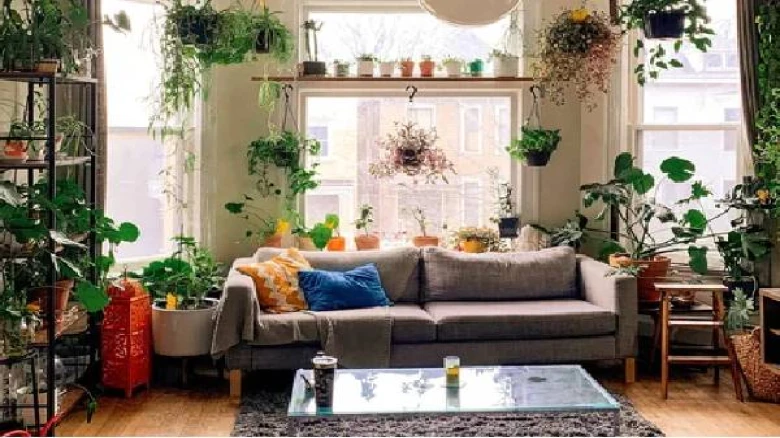Sports

A variety of indoor plants can help to increase oxygen levels in poorly ventilated houses while also reducing pollutants such as VOCs, Benzene, CO, and CO2. These can tolerate low light/artificial light and serve to refresh the environment in the home. Snake plants, ficus, spider plants, aglonema, deffenbachia, areca palms, and aloe vera are also good choices for fresh air in poorly ventilated homes and businesses.
Digital
Desk: Indoor air pollution affects 4.5 million people in India every year,
making it one of the most serious risks to human health and life. According to
the Air Quality Life Index (AQLI) report, air pollution reduces Indians' life
expectancy by five years, the majority of which is preventable. Indoor air can
be ten times more polluted than outdoor air, and with the shift to
work-from-home, IAQ has become a hot topic of debate, as people spend more than
15 hours indoors.
Many
people are unknowingly exposed to indoor air pollution and are unaware of the
consequences. Smoke from solid-fuel cooking, cigarettes, incense sticks, dhoop,
paint and varnish fumes, mosquito coils, repellents, and cleaning chemicals are
all major sources of indoor air pollution, and exposure to these pollutants can
significantly harm residents' health, resulting in respiratory, cardiovascular,
or endocrine disorders, as well as cancer in extreme cases.
"So
far, we have witnessed two levels of air pollutants - suspended particles (PM
Level) and microbiological level (equal to or below 0.1, Coronavirus),"
Kartik Singhal, Founder of O2 Cure and Managing Director at Zeco Aircon
Limited, said in an interview with HT Lifestyle. The third stage, hazardous
gases, is not, however, being emphasised. Last year, a haze cloud formed on the
Yamuna's waters, giving us a sight of it."
"To
kill the enemy, you must first recognise the adversary," he suggested,
adding that societal knowledge of air pollution should be prioritised. To balance
filtered air changes, smell, and carbon-dioxide levels in your house, maintain
ideal treated fresh air. Install the best air purifier technology to maintain
good indoor AQI levels for PM 2.5, TVOC, formaldehyde, and other pollutants, as
our furniture, rugs, carpets, curtains, and other items all emit air pollutants
that cause allergies. Finally, to reduce PM levels and enhance moisture content
or relative humidity in dwellings during the dry winter season, utilise a
humidifier."Adding to the list, Gaurav Kedia, Chairman of Indian Biogas
Association, suggested some ways that can be used to improve indoor air quality
and reduce air pollution in your home. These include:
The
first step is to open doors and windows to allow new air in while allowing
stale air to escape. In the case of air-conditioned rooms, the same precautions
must be taken. To allow fresh air in, open the doors/windows once a day. When
lighting cigarettes or incense sticks, windows should also be opened to allow
the smoke to escape.
color:black;mso-themecolor:text1">2. Wet Mopping On Floors/Objects:
font-weight:normal;mso-bidi-font-weight:bold">Wet mopping should be used to
collect settled PM particles whenever possible. The PM particles are unsettled
by dry dusting and persist in the ambient air for a long time, invading our
airways and creating discomfort.
font-weight:normal;mso-bidi-font-weight:bold">3. Plants:
font-weight:normal;mso-bidi-font-weight:bold"> A variety of indoor plants can
help to increase oxygen levels in poorly ventilated houses while also reducing
pollutants such as VOCs, Benzene, CO, and CO2. These can tolerate low
light/artificial light and serve to refresh the environment in the home. Snake
plants, ficus, spider plants, aglonema, deffenbachia, areca palms, and aloe
vera are also good choices for fresh air in poorly ventilated homes and
businesses.
font-weight:normal;mso-bidi-font-weight:bold">
4. Planting
Trees:
mso-themecolor:text1"> Banana, Mango, Neem, Peepal, Amla, Bel, Nariyal
(Coconut), Chandan, Lotus, Jasmine, Ashok Kadamb, Tulsi, and Parijat trees
should be encouraged since they provide unique environmental benefits (apart
from their fruits). According to SM Edwardes, a British India officer, about 78
types of trees were revered in various parts of India, and people were not
permitted to cut them down. Planting trees along road sides, walkways,
backyards, and front yards can result in millions of trees being planted,
lowering pollution and land exposure to hot sun radiation, resulting in cooler
and fresher surroundings.
Due
to a lack of space, some of these concepts will be unable to be executed. We
must educate our site management personnel, drivers, cleaners, and members of
the general public about the importance of not burning biodegradable garbage on
the highway. All biodegradable trash generated in the home should either be
composted or properly disposed of, not mixed with non-biodegradable waste.
Leave A Comment